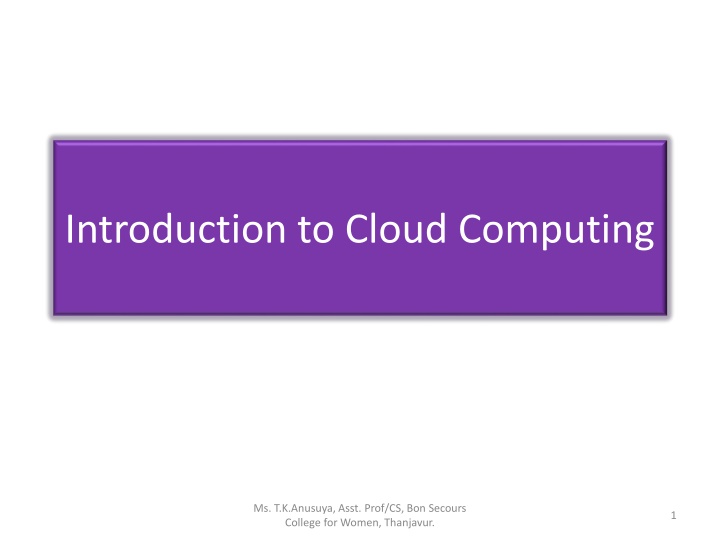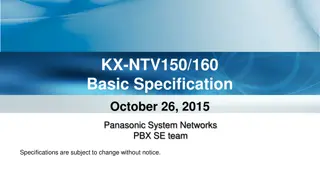
Cloud Computing Fundamentals
Explore the core concepts of cloud computing, including its definition, characteristics, and roots. Learn about how cloud computing leverages hardware-based services to offer scalable resources, pay-per-use models, and service-oriented architectures. Discover the evolution of cloud computing from Internet technologies to grid computing and the challenges it addresses. Gain insights into utility computing, virtualization, and the aggregation of distributed resources in cloud environments.
Download Presentation

Please find below an Image/Link to download the presentation.
The content on the website is provided AS IS for your information and personal use only. It may not be sold, licensed, or shared on other websites without obtaining consent from the author. If you encounter any issues during the download, it is possible that the publisher has removed the file from their server.
You are allowed to download the files provided on this website for personal or commercial use, subject to the condition that they are used lawfully. All files are the property of their respective owners.
The content on the website is provided AS IS for your information and personal use only. It may not be sold, licensed, or shared on other websites without obtaining consent from the author.
E N D
Presentation Transcript
Introduction to Cloud Computing Ms. T.K.Anusuya, Asst. Prof/CS, Bon Secours College for Women, Thanjavur. 1
Defining Cloud Computing Buyya defines: Cloud is a parallel and distributed computing system consisting of a collection of inter-connected and virtualized computers that are dynamically provisioned and presented as one or more unified computing resources based on service-level agreements (SLA) Vanquero defines: Clouds are a large pool of easily usable and accessible virtualized resources (such as hardware, development platforms and/or services). These resources can be dynamically reconfigured to adjust to a variable load (scale), allowing also for an optimum resource utilization Ms. T.K.Anusuya, Asst. Prof/CS, Bon Secours College for Women, Thanjavur. 2
Cloud is a h/w based services offering compute, n/w and storage management is highly abstracted from the buyer. Buyers incur infrastructure costs as variable OPEX, and infrastructure capacity is highly elastic NIST-national institute of Standards & Technology characterise cc as as pay per use model for enabling available, convenient, on-demand n/w access to a shared pool of configurable computing resources. capacity where h/w Ms. T.K.Anusuya, Asst. Prof/CS, Bon Secours College for Women, Thanjavur. 3
Roots of Cloud Computing Hardware H/w virtualization Multi core chips SOA Utility & grid Computing Web2.0 Internet Technologies Distributed Computing Web Services Mashups Autonomic computing Data Center Automation Systems Management Ms. T.K.Anusuya, Asst. Prof/CS, Bon Secours College for Women, Thanjavur. 4
Internet Technologies Utility Pay per use, elastic capacity, self service interface and virtualised SOA Service Oriented Architecture) software resources are packaged as a services ook WS Powerful services that accessed on- demand, in a uniform way. Service Mashups web information and services may be programmatically aggregated, acting as a building blocks of complex compositions. Eg. Amazon, google, facebook. Ms. T.K.Anusuya, Asst. Prof/CS, Bon Secours College for Women, Thanjavur. 5
Computing Grid Computing aggregation of distributed resources transparently access Problems QoS, Lack of performance Availability, Virtualization Utility Computing assign a utility value to users QoS constraints (deadline, importance, satisfaction) Ms. T.K.Anusuya, Asst. Prof/CS, Bon Secours College for Women, Thanjavur. 6
Hardware Virtualization Large scale data centers Multiple OS and software stacks on a single physical platform VMM-(Virtual machine monitor) also called hypervisor. Workload migration also referred to as application mobility VMM platforms exist that are the basis of many utility / cc environments. Eg. VMWare,Xen- hypervisor as a open source and KVM(Kernal based Virtual Machine) Ms. T.K.Anusuya, Asst. Prof/CS, Bon Secours College for Women, Thanjavur. 7
Ms. T.K.Anusuya, Asst. Prof/CS, Bon Secours College for Women, Thanjavur. 8
Autonomic Computing Autonomic or self-managing systems rely on monitoring probes and sensors (gauges) on an adaption engine and on effectors to carry out changes on the system. IBM s defines self configuration, self healing, self optimization and self protection. It is also called MAPE-K(Monitor Analyze Plan Execute- Knowledge). Ms. T.K.Anusuya, Asst. Prof/CS, Bon Secours College for Women, Thanjavur. 9
Layers and Types of Clouds Ms. T.K.Anusuya, Asst. Prof/CS, Bon Secours College for Women, Thanjavur. 10
IaaS: Infrastructure as a Service A cloud infrastructure enables on demand provisioning of servers running several choices of OS and a customized software stack. It is considered as the bottom layer of cloud computing system. Eg. Amazon Web Services mainly offers IaaS PaaS: Platform as a Service It is a higher level of abstraction to make a cloud easily . Eg. Google AppEngine. Data access, authentication and payments. Python and java specific programming language Ms. T.K.Anusuya, Asst. Prof/CS, Bon Secours College for Women, Thanjavur. 11
SaaS: software as a Service Top of the cloud stack On-line software services Traditional desktop apps such as word and spreadsheet can now be access in the web. Eg. Salesforce.com offers business productivityapplications(CRM) Ms. T.K.Anusuya, Asst. Prof/CS, Bon Secours College for Women, Thanjavur. 12
Deployment Models Ms. T.K.Anusuya, Asst. Prof/CS, Bon Secours College for Women, Thanjavur. 13
Desired Features of a Cloud This model satisfy expectations of consumers Cloud offers Self service Per-Usage Metering and Billing Elasticity Customization Ms. T.K.Anusuya, Asst. Prof/CS, Bon Secours College for Women, Thanjavur. 14
Cloud Infrastructure Management The software toolkit responsible for this orchestration is called a VIM(virtual infrastructure manager) This is a traditional OS Two category of VIM Toolkits that s expose a remote and sevure interface for creating, controlling and monitoring virtualize resources. Donot expose remote cloud like interfaces. Ms. T.K.Anusuya, Asst. Prof/CS, Bon Secours College for Women, Thanjavur. 15
Features of VIM Virtualization Support Self service, on-demand resource provisioning Multiple backend hypervisors Storage virtualization Interface to public clouds. Virtual networking Dynamic resource allocation Virtual clusters Ms. T.K.Anusuya, Asst. Prof/CS, Bon Secours College for Women, Thanjavur. 16
Features of IaaS Geographic distribution of data centers Variety of user interfaces and APIs to access the systems Specialized components(firewalls) Choice of virtualization platform and OS Different billing methods Post paid, prepaid Hours, monthly Ms. T.K.Anusuya, Asst. Prof/CS, Bon Secours College for Women, Thanjavur. 17
Features of PaaS Programming Models, Languages, and Frameworks Persistence Options Ms. T.K.Anusuya, Asst. Prof/CS, Bon Secours College for Women, Thanjavur. 18
Challenges and Risks Security, Privacy and Trust Data Lock-in and standardization Availability, fault tolerance and disaster recovery Resource Management and Energy - Efficiency Ms. T.K.Anusuya, Asst. Prof/CS, Bon Secours College for Women, Thanjavur. 19
Ms. T.K.Anusuya, Asst. Prof/CS, Bon Secours College for Women, Thanjavur. 20




